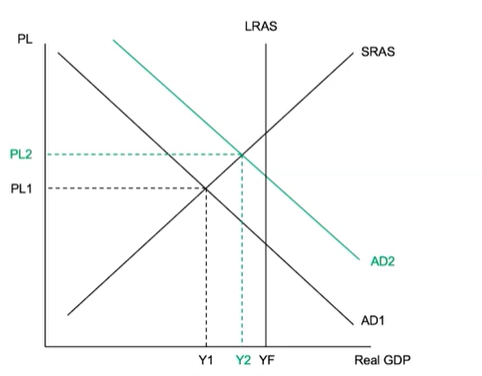Unit 4.6: Financial Sector
Monetary Policy
Monetary policy::
A central bank’s policies of influencing nominal interest rates to help achieve macroeconomic objectives:
Price stability
Full employment
Interest rate changes impact the price level, real output, and unemployment through shifts of AD
Monetary policy’s target interest rate
When banks are unable to meets the reserve requirement, they can:
Call in loans
Sell assets
Borrow from the central bank (pay discount rate)
Borrow from other commercial banks (pay policy rate)
Policy rate::
Overnight interbank lending rate
Called the federal funds rate in the US
Central banks often set a target range for the policy rate to guide monetary policy
Expansionary monetary policy::
When the central bank decreases nominal interest rates in the short run to help get an economy out of a recessionary gap
Lower interest rate => less expensive to borrow => more interest-sensitive spending (investment and consumption) => increase in AD
Contractionary monetary policy::
When the central bank increases nominal interest rates in the short run to get an economy out of an inflationary gap
Higher interest rates => more expensive to borrow => less interest-sensitive spending (investment and consumption) => decrease in AD
Monetary policy lags
Recognition lag::
It takes central banks time to collect and analyze the data needed to recognize problems in the economy
Impact (or operational) lag::
It takes time for the economy to adjust after the policy action is taken
Limited reserves
In a limited reserves framework, interest rate changes are brought about through shifts of the money supply
Limited reserves framework::
A banking system in which:
Reserves are not overly abundant
There is a nonzero reserve requirement
Commercial banks hold required reserves and possibly also excess reserves
Monetary policy works by changing the supply of excess reserves and therefore the supply of money
Changing the money supply results in changes to the nominal interest rate
Limited Reserves monetary policy tools
a) Required reserve ratio::
The percentage of demand (checkable) deposits banks must hold in their reserves
If it decreases
Banks have more excess reserves to lend
MS (money supply) increases (nominal interest rate falls or NIR)
If it increases
Banks have less excess reserves to lend
MS decreases (nominal interest rate rises)
b) Discount rate::
The interest rate commercial banks must pay to borrow from the central bank
Decreases:
Banks encouraged to lend more
MS increases (nominal interest rate falls)
Increases:
Banks encouraged to lend less
MS decreases (nominal interest rate rises)
c) Open market operations (OMO)::
Central bank buying and selling of government bonds (securities)
Central bank buys bonds (OM purchase)
Banks’ excess reserves increases
MS increases (NIR falls)
Central bank sells bonds (OM sale)
Banks’ excess reserves decreases
MS decreases (NIR rises)
The money multiplier
OMO causes changes in reserves, so the monetary base changes
In limited reserves environments, the effect of an OMO on the MS is greater than the effect on the monetary base because of the money multiplier
An increase in excess reserves (OMO purchases) leads banks to make more loans, which leads to more deposits, which creates more excess reserves, which allows for more loans
A decrease in excess (OMO sale) works the opposite way
Maximum possible value of money multiplier:
Money multiplier = 1 / required reserve ratio
Based on assumptions:
Banks hold no excess reserves
Borrowers spend their entire loans
Customers hold no cash
Maximum possible change to MS as a result of an OMO:
Change to MS = OMO amount * money multiplier
Open market operations effects
Liabilities don’t change, but money is moved around in the assets section
change a bank’s excess reserves by the entire amount of the purchase (increase) or sale (decrease)
Required reserve ratio doesn’t apply to OMO
change a bank’s bond holding amount by the entire amount of the purchase (decrease) or sale (increase)
Ample Reserves
Tied to central bank of the US (federal reserve)
In a limited reserves framework, interest rate changes are brought about through changes to administered interest rates
Ample reserves framework::
A banking system in which:
Reserves are abundant
The required reserve ratio is zero
Changing the MS no longer leads to changes in nominal interest rates
Different monetary policy tools are needed
The money market graph is not used to model an ample reserves banking system, the reserve market model is
Policy rate (federal funds rate in the US) is important in the model used for this framework
Policy rate is set at the intersection of SR (supply of reserves) and DR (demand for reserves)
In ample reserves, SR intersects the lower horizontal portion of DR
Buying bonds is used to maintain ample reserves (not a monetary policy tool in this case)
The monetary base increases, but there is no impact on interest rates
Reserve market model:
Ample Reserves monetary policy tools (used by Fed)
a) Administered interest rates, including:
Interest on reserves (IOR)::
The interest rate commercial banks earn on the funds in their reserve balances accounts with the Fed
Fed’s primary monetary policy tool
increases to IOR move up the lower bound (lower horizontal area on DR) on the reserve market model graph
Decreases to IOR move the lower bound down
Discount rate::
Same definition as under limited reserves, but the central bank is the Fed in the US
increases to discount rate move up the upper bound (higher horizontal area on DR) on the reserve market model graph
Decreases to discount rate move the upper bound down
Expansionary policy
A decrease in these administered interest rates leads to a decrease in the policy rate then a decrease in other nominal interest rates
Interest-sensitive spending and AD will increase
Contractionary policy
An increase in these administered interest rates leads to an increase in the policy rate then an increase in other nominal interest rates
Interest-sensitive spending and AD will decrease
 Knowt
Knowt







